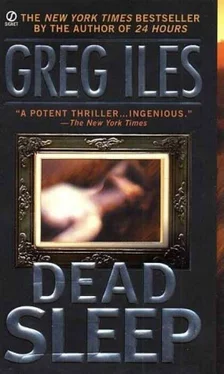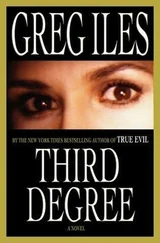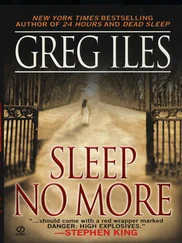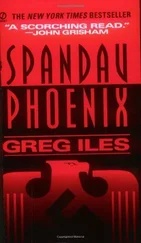“Ms. Glass, from the moment you called me from your return flight from Hong Kong, we’ve been using the combined weight of the Departments of Justice and State to gather the Sleeping Women paintings for forensic analysis. Negotiations like these usually take weeks, but the exigencies of this situation allowed us to apply unprecedented pressure. We now have six paintings in our possession. We’ve already begun our analysis, using both our own technicians and outside consultants. The bad news is, we’ve found no fingerprints preserved in the paint.”
“Damn,” curses Bowles.
“There are hundreds of prints on the frames, of course, but they’re probably meaningless. We have found traces of talc in the paint, which suggests that the artist wore surgical gloves while doing his work. We have what we believe to be the first painting, and it tests positive for talc, which means the UNSUB was intent on protecting his identity from the start. This guy doesn’t learn as he goes. He’s a savant. We’re X-raying the paintings to find out if there are any hidden messages or ghosts, but we-”
“What’s that?” asks Bowles. “A ghost?”
“A painting beneath a painting,” says Lenz, speaking for the first time.
“X rays might also detect fingerprints on the canvas beneath the paint,” Baxter continues. “Our UNSUB may not have been so careful as he made sketches, knowing that the surface would soon be covered with paint.”
“I wouldn’t count on that,” Kaiser says. “Artists know about X-ray analysis.”
“I’m glad you’re letting me in on all this,” I say to the screen. “But what’s it leading to? What’s the urgency?”
“Bear with me,” says Baxter. “We’ve made arrangements for eight paintings to be shipped to us in Washington. The owners of six more – all in Asia – have given us permission to send forensic teams to their homes or galleries to make the necessary studies. Those teams are en route now.”
“That leaves five,” says Kaiser. “Nineteen total, right?”
Baxter nods. “The remaining five are owned by a man named Marcel de Becque.”
“A Frenchman?” asks Bowles.
Something ticks in my brain, something Christopher Wingate said.
“It’s more complicated than that,” says Baxter. “De Becque was born in Algeria in 1930, but reared in Vietnam. His father was a French colonial businessman who put his money into tea plantations.”
“And he lives in the Cayman Islands,” I finish.
“How did you know that?” Baxter asks sharply.
“Wingate mentioned him.”
“De Becque won’t send us his paintings? ”asks Kaiser.
“He’s not only refused to ship his paintings to us, but also refused to allow our forensic teams to go to his estate on Grand Cayman to study them.”
Kaiser and Lenz share a look.
“What reason did he give?” asks the psychiatrist.
“He said it was inconvenient.”
“Frog son of a bitch,” growls Bowles. “What’s he doing in the Caymans? Probably running from something.”
“He is,” Baxter confirms. “In 1975, while we scraped the last Americans off the Saigon Embassy roof by helicopter, de Becque was slipping out in a private plane. He’d sold his plantations just before the Tet offensive, which is suspicious in and of itself. He was tied to intelligence people on both sides, and he undoubtedly played both ends against the middle when he could. Word is, he was heavily involved in the unofficial war economy throughout the conflict.”
“Black marketeer,” Kaiser says with obvious distaste.
“Four years ago,” says Baxter, “Marcel de Becque was implicated in a stock-fraud scheme on the Paris Bourse. The scam involved a fraudulent platinum discovery in Africa. He had to flee, but he netted close to fifty million from the deal.”
Bowles whistles from his desk.
“The French can’t extradite him from Cayman, because at some point he established residency in Quebec and obtained Canadian citizenship. Canada and the Caymans have no extradition treaty. We can extradite from Cayman, but de Becque has committed no crime on U.S. soil. He’s immune to pressure from us.”
“As far as we know,” says Bowles, “if we got enough evidence to issue an arrest warrant on conspiracy, we could go in and bring him back under the new laws.”
“That’s not an option at this time, Pat,” says Baxter.
Kaiser unexpectedly voices my thought for me. “What does all this have to do with Jordan Glass?”
Baxter turns to me again. “Monsieur de Becque has made a very unusual proposition. He personally told me that he would allow his Sleeping Women – that’s how he refers to them, as though they’re real women – he would allow them to be photographed – not forensically examined, mind you – but only if the photographer was Jordan Glass.”
The room goes silent, and cold apprehension climbs my spine.
“Why in the world would he ask for me?”
“I was hoping you could shed some light on that,” says Baxter.
“Maybe de Becque is the killer,” suggests Bowles. “He killed Jane Lacour, and now he’s discovered she has a twin sister. He wants to do her as well. Make a set.”
In a voice dripping with disdain, Lenz says, “Please confine your theories to subjects with which you’re familiar. Like bank robbery.”
“Arthur,” Baxter warns.
Bowles is so red he looks ready to pop a blood vessel.
“De Becque is seventy years old,” says Baxter. “He falls well outside all profiles for serial murder.”
“This may not be serial murder,” says Kaiser, earning odd looks from the other men. “And de Becque could easily be behind the selections. We need to find out if he’s come to New Orleans in the past eighteen months, and if so, how often.”
“De Becque owns his own jet,” says Baxter. “A Cessna Citation.”
Kaiser’s eyebrows go up.
“We’re trying to trace its movements now.”
Lenz focuses on Kaiser. “Do you really think a murderer – or a kidnapper – who’s been so careful up to this point would invite his next victim to his lair through the medium of the FBI?”
“He might,” says Kaiser, “as a joke. A final joke. He’s getting old. He knows we’ve discovered the link between his victims and the paintings. He killed Wingate, or ordered his death, so his marketing conduit’s shut down. One way or another, he knows he hasn’t got much time. So he decides to immortalize himself by the way he goes out. Murder-suicide with a celebrity.”
Despite the antipathy between Kaiser and Lenz, the psychiatrist seems to be weighing this theory. “If he’s the suicidal type, why bother to kill Wingate at all?”
“Knee-jerk response. Like people who kill every snake they see. He perceived a threat and neutralized it before fully exploring how it would affect his situation.”
Lenz purses his lips in thought. “Did de Becque’s jet fly to New York yesterday?”
“No,” says Baxter. “It was on Grand Cayman for the past twenty-four hours. We’ve confirmed that. We are checking commercial carriers.”
“You can forget that,” mutters Lenz.
“De Becque says he’ll send his jet to pick up Ms. Glass and her equipment,” says Baxter. “The catch is, she has to go alone.”
Kaiser looks incredulous. “You’re not actually considering this.”
“John, we have to look at-”
Kaiser whirls on Lenz. “How long have you known about de Becque?”
“I heard what you did, when you did,” Lenz says quietly. Which is not exactly a denial.
“I’ll do it,” I tell them.
The room goes quiet again.
“If you do,” says Baxter, “it won’t be under de Becque’s conditions.”
“Under no conditions,” says Kaiser. “We have no control down there.”
Читать дальше
Конец ознакомительного отрывка
Купить книгу












